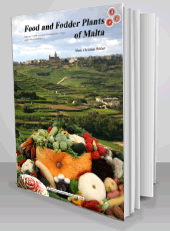Scientific & Academic Publishing
SAP is an open access publisher of journals covering a wide range of academic disciplines.

Food and Fodder Plants of Malta
- Hans Christian Weber graduated with a master degree in Biology from the Justus-Liebig University Giessen, Germany, and completed his PhD in 1976. He was research assistant and assistant lecture at the University of Ulm (1975-1982) and has been professor of Botany at the Philipps University of Marburg since 1982.
- ISBN: 978-0-9838996-1-7
Description
Food and Fodder Plants of Malta is not intended to be a special book on Malta’s agriculture: it is a book about the biology of useful, particularly edible plants grown or cultivated in Malta, and it is clearly also of interest to other countries in the Mediterranean region or areas with subtropical climates.
In an expanded introduction, complemented by about 600 full colour photographs, examples of indigenous plants growing in the wild, as well as ornamentals grown in gardens, are introduced with examples of useful technical (dyes, fiber, wood, rubber, resins, tanning materials, pharmaceutical and medicinal products, and fodder) and edible (food, sugar and starch, oil and fat, colouring, condiments, and drinks) plants, and their potential uses explored.
The 2 chapters at the end of the book (Lists of scientific, English, German, Italian and Maltese names of plants and the Index) will be immensely helpful for locating specific information in the book.
The information contained within this book and the rich photographic material with photos of high quality make the book attractive for a wide range of readers. It is interesting to read the text because it is not too technical and can be easily understood by anyone. Therefore, Food and Fodder Plants of Malta will be an indispensable tool for individuals who need to access information about useful, particularly edible plants, such as students of agronomy, agriculture, biology, botany, ecology, or food science, and it will also be used by many teachers for their work. It will also serve as an interesting book for plant lovers and tourists visiting Malta who desire to know more about the country. Finally, the book will be of interest to all plant lovers in Malta and worldwide, who simply wish to learn a little more about the richness of useful plants, including plenty of secrets and strange facts:
• To understand why it is impossible to find a Fig in flower, or what happens when the Caper buds are not reachable for hand-picking;
• Why Mulberry is not actually a berry and not even a fruit;
• To learn that the Pecan fruit was long thought to be technically a drupe, but is actually a true nut;
• To see the variability of Cabbage or Pumpkin; or
• Just to see what a Broccoli flower or a Parsley flower look like, and an Artichoke inflorescence when not harvested before they flower!
Table of Contents
Introduction
Useful technical plants potential for use
Useful edible plants potential for use
Descriptions
Food and Fodder plants in use
Fungi
Gymnosperms
Magnoliids
Monocots
Asparagales-Poales-Zingiberales
Eudicots
Vitales
Rosids
Caryophyllales-Myrtales
Malpighiales-Cucurbitales
Fagales-Fabales-Rosales
Sapindales-Malvales-Brassicales
Asterids
Ericales-Boraginales-Lamiales-Solanales
Asterales-Apiales
References
Acknowledgments
List of Scientific, English, German, Italian and Maltese Names
Index
